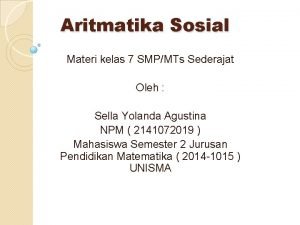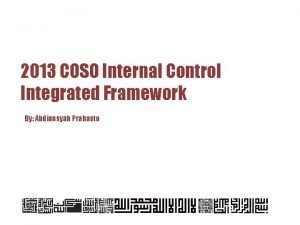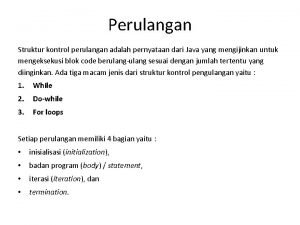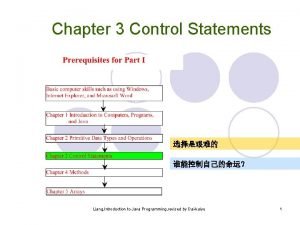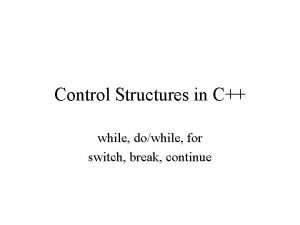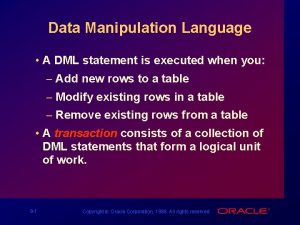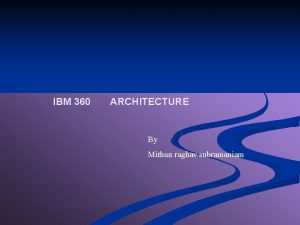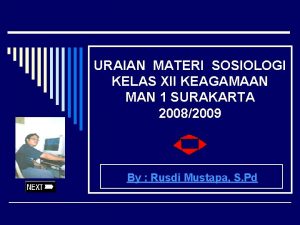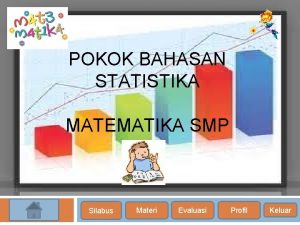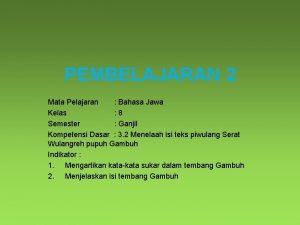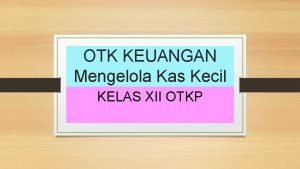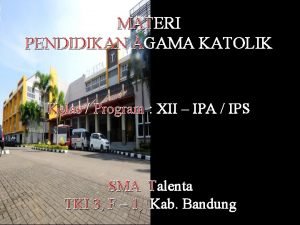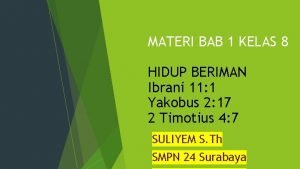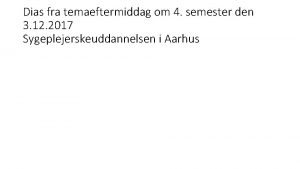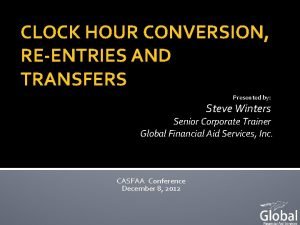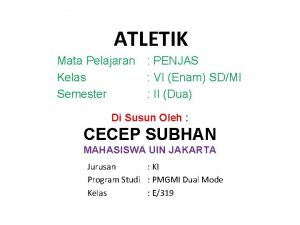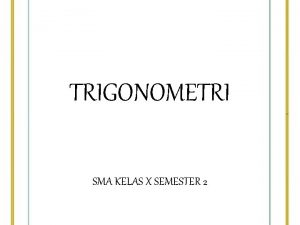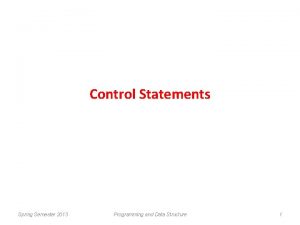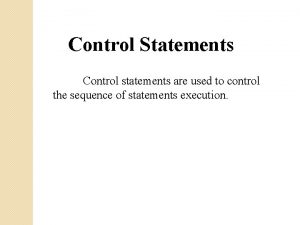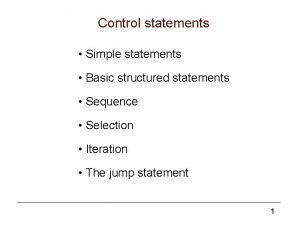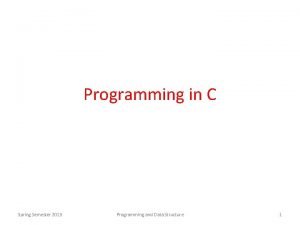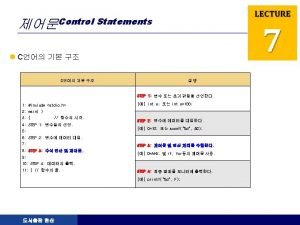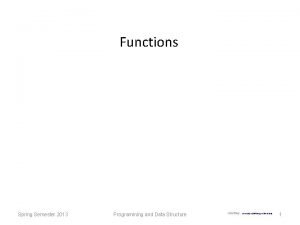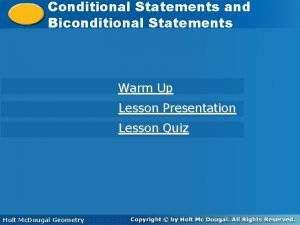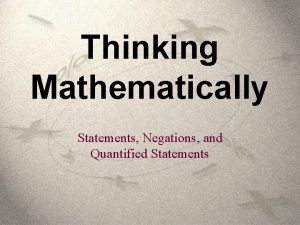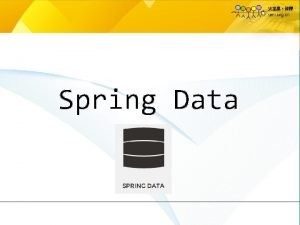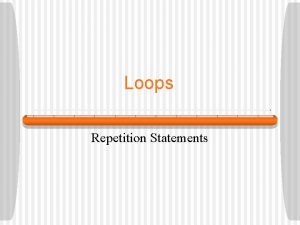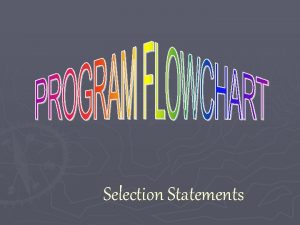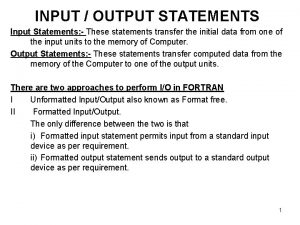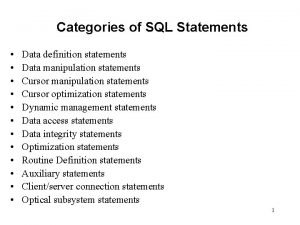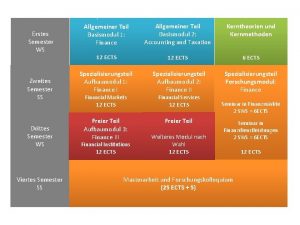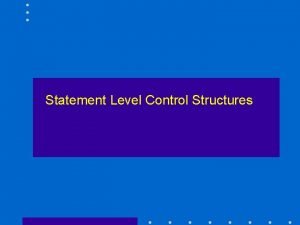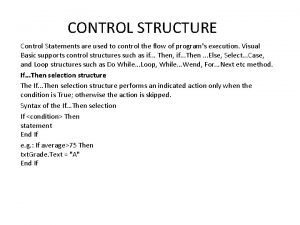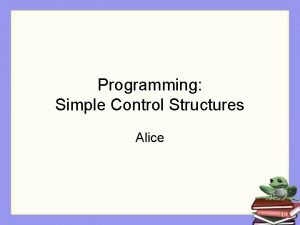Control Statements Spring Semester 2013 Programming and Data


























































- Slides: 58

Control Statements Spring Semester 2013 Programming and Data Structure 1

What do they do? • Allow different sets of instructions to be executed depending on the outcome of a logical test. – Whether TRUE or FALSE. – This is called branching. • Some applications may also require that a set of instructions be executed repeatedly, possibly again based on some condition. – This is called looping. Spring Semester 2013 Programming and Data Structure 2

How do we specify the conditions? • Using relational operators. – Four relation operators: – Two equality operations: <, <=, >, >= ==, != • Using logical operators / connectives. – Two logical connectives: – Unary negation operator: Spring Semester 2013 Programming and Data Structure &&, | | ! 3

Examples count <= 100 (math+phys+chem)/3 >= 60 (sex==‘M’) && (age>=21) (marks>=80) && (marks<90) (balance>5000) | | (no_of_trans>25) ! (grade==‘A’) ! ((x>20) && (y<16)) Spring Semester 2013 Programming and Data Structure 4

The conditions evaluate to … • Zero – Indicates FALSE. • Non-zero – Indicates TRUE. – Typically the condition TRUE is represented by the value ‘ 1’. Spring Semester 2013 Programming and Data Structure 5

Branching: The if Statement • Diamond symbol (decision symbol) - indicates decision is to be made. – Contains an expression that can be TRUE or FALSE. – Test the condition, and follow appropriate path. • Single-entry / single-exit structure. • General syntax: if (condition) { ……. . } – If there is a single statement in the block, the braces can be omitted. Spring Semester 2013 Programming and Data Structure 6

The if Selection Structure true grade >= 60 print “Passed” A decision can be made on any expression. zero - false nonzero - true if (grade>=60) printf(“Passed n”); Spring Semester 2013 Programming and Data Structure 7

Example #include <stdio. h> main() { int a, b, c; scanf (“%d %d %d”, &a, &b, &c); if ((a>=b) && (a>=c)) printf (“n The largest number is: %d”, a); if ((b>=a) && (b>=c)) printf (“n The largest number is: %d”, b); if ((c>=a) && (c>=b)) printf (“n The largest number is: %d”, c); } Spring Semester 2013 Programming and Data Structure 8

Branching: The if-else Statement • Also a single-entry / single-exit structure. • Allows us to specify two alternate blocks of statements, one of which is executed depending on the outcome of the condition. • General syntax: if (condition) { …… block 1 ……. } else { ……. . block 2 ……. . } – If a block contains a single statement, the braces can be deleted. Spring Semester 2013 Programming and Data Structure 9

The if/else Selection Structure false grade >= 60 true print “Passed” print “Failed” if ( grade >= 60 ) printf( "Passedn"); else printf( "Failedn"); Spring Semester 2013 Programming and Data Structure 10

if-else syntax if ( expression ) { statement 1; statement 2; . statement_n; } if (grade>=60) printf(“Passed n”); Spring Semester 2013 if ( expression ) { statement_1; statement_2; . statement_n; } else { Statement_1; . Statement_m; } if ( grade >= 60 ) printf( "Passedn"); else printf( "Failedn"); Programming and Data Structure 11

Nesting of if-else Structures • It is possible to nest if-else statements, one within another. • All if statements may not be having the “else” part. – Confusion? ? • Rule to be remembered: – An “else” clause is associated with the closest preceding unmatched “if”. Spring Semester 2013 Programming and Data Structure 12

if e 1 s 1 else if e 2 s 2 else s 3 if e 1 if e 2 s 1 else s 2 else s 3 ? if e 1 if e 2 s 1 else s 2 Spring Semester 2013 Programming and Data Structure 13

if e 1 s 1 else if e 2 s 2 else s 3 if e 1 if e 2 s 1 else s 2 Spring Semester 2013 Programming and Data Structure 14

Example #include <stdio. h> main() { int a, b, c; scanf (“%d %d %d”, &a, &b, &c); if (a>=b) if (a>=c) printf (“n The largest number is: %d”, a); else printf (“n The largest number is: %d”, c); else if (b>=c) printf (“n The largest number is: %d”, b); else printf (“n The largest number is: %d”, c); } Spring Semester 2013 Programming and Data Structure 15

Example #include <stdio. h> main() { int a, b, c; scanf (“%d %d %d”, &a, &b, &c); if ((a>=b) && (a>=c)) printf (“n The largest number is: %d”, a); else if (b>c) printf (“n The largest number is: %d”, b); else printf (“n The largest number is: %d”, c); } Spring Semester 2013 Programming and Data Structure 16

Confusing Equality (==) and Assignment (=) Operators • Dangerous error – Does not ordinarily cause syntax errors – Any expression that produces a value can be used in control structures – Nonzero values are true, zero values are false • Example: if ( pay. Code == 4 ) printf( "You get a bonus!n" ); Checks paycode, if it is 4 then a bonus is awarded Equality check improper if ( pay. Code = 4 ) printf( "You get a bonus!n" ); Spring Semester 2013 Equality check proper if ( pay. Code == 4 ) printf( "You get a bonus!n" ); Programming and Data Structure 18

Generalization of expression evaluation in C • Assignment (=) operation is also a part of expression. Returns the value 3 after assigning it to i. i=3; int i=4, j ; if(i=3) j=0; else j=1; Spring Semester 2013 j? int i=4, j ; if(i==3) j=0; Whatever be the value of i, else j is always 0. j=1; Programming and Data Structure j=1 19

More about expressions • Increment (++) and Decrement (--)Operations --i; ++i; Prefix operation First increment / decrement and then used in evaluation i++; Postfix operation i--; increment / decrement operation after being used in evaluation int t, m=1; t=++m; Spring Semester 2013 m=2; t=2; int t, m=1; t=m++; Programming and Data Structure m=2; t=1; 20

Some More Examples Initial values : : a = 10; b = 20; x = 50 + ++a; a = 11, x = 61 x = 50 + a++; x = 60, a = 11 x = a++ + --b; b = 19, x = 29, a = 11 x = a++ – ++a; Spring Semester 2013 Undefined value (implementation dependent) Programming and Data Structure 21

Ternary conditional operator (? : ) – Takes three arguments (condition, value if true, value if false) – Returns the evaluated value accordingly. grade >= 60 ? printf( “Passedn” ) : printf( “Failedn” ); (expr 1)? (expr 2): (expr 3); Example: interest = (balance>5000) ? balance*0. 2 : balance*0. 1; Returns a value Spring Semester 2013 Programming and Data Structure 22

The switch Statement • This causes a particular group of statements to be chosen from several available groups. – Uses “switch” statement and “case” labels. – Syntax of the “switch” statement: switch (expression) { case expression-1: { ……. . } case expression-2: { ……. . } case expression-m: { ……. . } default: { ……… } } Spring Semester 2013 Programming and Data Structure 23

The switch Multiple-Selection Structure case a true case a action(s) break case b action(s) break case z action(s) break false case b true false. . . case z true false default action(s) Spring Semester 2013 Programming and Data Structure 24

Example switch ( letter ) { case 'A': printf("First lettern"); break; case 'Z': printf("Last lettern"); break; default : printf("Middle lettern"); break; } Spring Semester 2013 Programming and Data Structure 25

Example switch (choice = toupper(getchar())) { case ‘R’: case ‘G’: case ‘B’: default: printf (“RED n”); break; printf (“GREEN n”); break; printf (“BLUE n”); break; printf (“Invalid choice n”); } Spring Semester 2013 Programming and Data Structure 26

Example switch (choice = getchar()) { case ‘r’: case ‘R’: case ‘g’: case ‘G’: case ‘b’: case ‘B’: default: printf (“RED n”); break; printf (“GREEN n”); break; printf (“BLUE n”); break; printf (“Invalid choice n”); } Spring Semester 2013 Programming and Data Structure 28

The break Statement • Used to exit from a switch or terminate from a loop. – Already illustrated in the switch examples. • With respect to “switch”, the “break” statement causes a transfer of control out of the entire “switch” statement, to the first statement following the “switch” statement. Spring Semester 2013 Programming and Data Structure 29

The Essentials of Repetition • Loop – Group of instructions computer executes repeatedly while some condition remains true • Counter-controlled repetition – Definite repetition - know how many times loop will execute – Control variable used to count repetitions • Sentinel-controlled repetition – Indefinite repetition – Used when number of repetitions not known – Sentinel value indicates "end of data" Spring Semester 2013 Programming and Data Structure 30

Counter-Controlled Repetition • Counter-controlled repetition requires – name of a control variable (or loop counter). – initial value of the control variable. – condition that tests for the final value of the control variable (i. e. , whether looping should continue). – increment (or decrement) by which the control variable is modified each time through the loop. int counter =1; //initialization while (counter <= 10) { //repetition condition printf( "%dn", counter ); ++counter; //increment } Spring Semester 2013 Programming and Data Structure 31

Counter-Controlled Repetition • Counter-controlled repetition requires – name of a control variable (or loop counter). – initial value of the control variable. – condition that tests for the final value of the control variable (i. e. , whether looping should continue). – increment (or decrement) by which the control variable is modified each time through the loop. int counter; for (counter=1; counter<=10; counter++) printf(“%dn”, counter); Spring Semester 2013 Programming and Data Structure 32

while Statement while (condition) statement_to_repeat; /* Weight loss program */ while ( weight > 65 ) { printf("Go, exercise, "); printf("then come back. n"); printf("Enter your weight: "); scanf("%d", &weight); } while (condition) { statement_1; . . . statement_N; } int digit = 0; while (digit <= 9) printf (“%d n”, digit++); Spring Semester 2013 Programming and Data Structure 33

false C true Single-entry / single-exit structure statement(s) Spring Semester 2013 Programming and Data Structure 34

do-while Statement do { /* Weight loss program */ do { printf("Go, exercise, "); printf("then come back. n"); printf("Enter your weight: "); scanf("%d", &weight); } while ( weight > 65 ) ; statement-1 statement-2. . statement-n } while ( condition ); At least one round of exercise ensured. Spring Semester 2013 Programming and Data Structure 35

statement(s) Single-entry / single-exit structure false C true int digit = 0; do printf (“%d n”, digit++); while (digit <= 9); Spring Semester 2013 Programming and Data Structure 36

for Statement for (initial; condition; iteration) statement_to_repeat; All are expressions. initial expr 1 condition expr 2 iteration expr 3 for (initial; condition; iteration) { statement_1; . . . statement_N; fact = 1; /* Calculate 10 ! */ } for ( i = 1; i < =10; i++) fact = fact * i; Spring Semester 2013 Programming and Data Structure No semicolon after last expression 37

• How it works? – “expression 1” is used to initialize some variable (called index) that controls the looping action. – “expression 2” represents a condition that must be true for the loop to continue. – “expression 3” is used to alter the value of the index initially assigned by “expression 1”. int digit; for (digit=0; digit<=9; digit++) printf (“%d n”, digit); Spring Semester 2013 Programming and Data Structure 38

• How it works? – “expression 1” is used to initialize some variable (called index) that controls the looping action. – “expression 2” represents a condition that must be true for the loop to continue. – “expression 3” is used to alter the value of the index initially assigned by “expression 1”. Spring Semester 2013 Programming and Data Structure 39

int digit; expression 1 for (digit=0; digit<=9; digit++) printf (“%d n”, digit); expression 2 false true Single-entry / single-exit structure statement(s) expression 3 Spring Semester 2013 Programming and Data Structure 40

The For Structure: Notes and Observations • Arithmetic expressions – Initialization, loop-continuation, and increment can contain arithmetic expressions. – e. g. Let x = 2 and y = 10 Increment for ( j = x; j <= 4 * x * y; j += y / x ) is equivalent to Initialization Loop continuation for ( j = 2; j <= 80; j += 5 ) • "Increment" may be negative (decrement) • If loop continuation condition initially false – Body of for structure not performed – Control proceeds with statement after for structure Spring Semester 2013 Programming and Data Structure 41

for : : Examples int fact = 1, i; int sum = 0, N, count; for (i=1; i<=10; i++) fact = fact * i; scanf (“%d”, &N); for (i=1; i<=N, i++) sum = sum + i * i; printf (“%d n”, sum); Spring Semester 2013 Programming and Data Structure 42

• The comma operator – We can give several statements separated by commas in place of “expression 1”, “expression 2”, and “expression 3”. for (fact=1, i=1; i<=10; i++) fact = fact * i; for (sum=0, i=1; i<=N, i++) sum = sum + i * i; Spring Semester 2013 Programming and Data Structure 43

Specifying “Infinite Loop” for (; ; ) { statements } while (1) { statements } do { statements } while (1); Spring Semester 2013 Programming and Data Structure 44

break Statement • Break out of the loop { } – can use with • while • do while • for • switch – does not work with • if {} • else {} Causes immediate exit from a while, for, do/while or switch structure Program execution continues with the first statement after the structure Common uses of the break statement Escape early from a loop Skip the remainder of a switch structure Spring Semester 2013 Programming and Data Structure 45

A Complete Example #include <stdio. h> main() { int fact, i; fact = 1; i = 1; } while ( i<10 ) { /* run loop –break when fact >100*/ fact = fact * i; if ( fact > 100 ) { printf ("Factorial of %d above 100", i); break; /* break out of the while loop */ } i ++ ; } Spring Semester 2013 Programming and Data Structure 46

continue Statement • continue – Skips the remaining statements in the body of a while, for or do/while structure • Proceeds with the next iteration of the loop – while and do/while • Loop-continuation test is evaluated immediately after the continue statement is executed – for structure • Increment expression is executed, then the loop-continuation test is evaluated. expression 3 is evaluated, then expression 2 is evaluated. Spring Semester 2013 Programming and Data Structure 47

An Example with “break” & “continue” fact = 1; i = 1; while (1) { fact = fact * i; i ++ ; if ( i<10 ) continue; /* a program to calculate 10 ! /* not done yet ! Go to loop and perform next iteration*/ break; } Spring Semester 2013 Programming and Data Structure 48

Some Examples Spring Semester 2013 Programming and Data Structure 49

Example 1: Test if a number is prime or not #include <stdio. h> main() { int n, i=2; scanf (“%d”, &n); while (i < n) { if (n % i == 0) { printf (“%d is not a prime n”, n); exit; } i++; } printf (“%d is a prime n”, n); } Spring Semester 2013 Programming and Data Structure 50

More efficient? ? #include <stdio. h> main() { int n, i=3; scanf (“%d”, &n); while (i < sqrt(n)) { if (n % i == 0) { printf (“%d is not a prime n”, n); exit; } i = i + 2; } printf (“%d is a prime n”, n); } Spring Semester 2013 Programming and Data Structure 51

Example 2: Find the sum of digits of a number #include <stdio. h> main() { int n, sum=0; scanf (“%d”, &n); while (n != 0) { sum = sum + (n % 10); n = n / 10; } printf (“The sum of digits of the number is %d n”, sum); } Spring Semester 2013 Programming and Data Structure 52

Example 3: Decimal to binary conversion #include <stdio. h> main() { int dec; scanf (“%d”, &dec); do { printf (“%2 d”, (dec % 2)); dec = dec / 2; } while (dec != 0); printf (“n”); } Spring Semester 2013 Programming and Data Structure 53

Example 4: Compute GCD of two numbers #include <stdio. h> main() { int A, B, temp; scanf (%d %d”, &A, &B); if (A > B) { temp = A; A = B; B = temp; } while ((B % A) != 0) { temp = B % A; B = A; A = temp; } printf (“The GCD is %d”, A); } Spring Semester 2013 12 ) 45 ( 3 36 9 ) 12 ( 1 9 3 ) 9 ( 3 9 0 Initial: A=12, B=45 Iteration 1: temp=9, B=12, A=9 Iteration 2: temp=3, B=9, A=3 B % A = 0 GCD is 3 Programming and Data Structure 54

Shortcuts in Assignments • Additional assignment operators: + =, – =, * =, / =, % = a += b is equivalent to a = a + b a *= (b+10) is equivalent to a = a * (b + 10) and so on. Spring Semester 2013 Programming and Data Structure 55

More about scanf and printf Spring Semester 2013 Programming and Data Structure 56

Entering input data : : scanf function • General syntax: scanf (control string, arg 1, arg 2, …, argn); – “control string refers to a string typically containing data types of the arguments to be read in; – the arguments arg 1, arg 2, … represent pointers to data items in memory. Example: scanf (%d %f %c”, &average, &type); • The control string consists of individual groups of characters, with one character group for each input data item. – ‘%’ sign, followed by a conversion character. Spring Semester 2013 Programming and Data Structure 57

– Commonly used conversion characters: c d f s X single character decimal integer floating-point number string terminated by null character hexadecimal integer – We can also specify the maximum field-width of a data item, by specifying a number indicating the field width before the conversion character. Example: scanf (“%3 d %5 d”, &a, &b); Spring Semester 2013 Programming and Data Structure 58

Writing output data : : printf function • General syntax: printf (control string, arg 1, arg 2, …, argn); – “control string refers to a string containing formatting information and data types of the arguments to be output; – the arguments arg 1, arg 2, … represent the individual output data items. • The conversion characters are the same as in scanf. Spring Semester 2013 Programming and Data Structure 59

• Examples: printf (“The average of %d and %d is %f”, a, b, avg); printf (“Hello n. Good n. Morning n”); printf (“%3 d %5 d”, a, b, a*b+2); printf (“%7. 2 f %5. 1 f”, x, y); • Many more options are available: – Read from the book. – Practice them in the lab. • String I/O: – Will be covered later in the class. Spring Semester 2013 Programming and Data Structure 60
 Aritmetika sosial kelas 7
Aritmetika sosial kelas 7 Spring, summer, fall, winter... and spring (2003)
Spring, summer, fall, winter... and spring (2003) Seasons months
Seasons months Coso integrated framework 2013
Coso integrated framework 2013 Hdlc adalah
Hdlc adalah Perbedaan linear programming dan integer programming
Perbedaan linear programming dan integer programming Greedy programming vs dynamic programming
Greedy programming vs dynamic programming System programming vs application programming
System programming vs application programming Integer programming vs linear programming
Integer programming vs linear programming Programing adalah
Programing adalah Salon big data 2013
Salon big data 2013 Perulangan bersarang java
Perulangan bersarang java Flowchart do while
Flowchart do while Control statements in java
Control statements in java Setprecision in c++
Setprecision in c++ Product control
Product control Negative vs positive control operon
Negative vs positive control operon Error control and flow control
Error control and flow control Data manipulation language statements
Data manipulation language statements High tide
High tide Data formats of ibm 360
Data formats of ibm 360 Materi sosiologi kelas 12
Materi sosiologi kelas 12 Materi desain grafis kelas 10 semester 2
Materi desain grafis kelas 10 semester 2 Us history final exam study guide
Us history final exam study guide Tugas tik kelas 9 semester 2
Tugas tik kelas 9 semester 2 Materi tik kelas 8
Materi tik kelas 8 Chemistry semester 2 review unit 12 thermochemistry
Chemistry semester 2 review unit 12 thermochemistry Kompetensi dasar kelas 3 semester 2
Kompetensi dasar kelas 3 semester 2 Negara yang ditunjukkan oleh anak panah beribukota di
Negara yang ditunjukkan oleh anak panah beribukota di Wharton mbacm
Wharton mbacm English 11 first semester exam
English 11 first semester exam Situational irony def
Situational irony def Pointing
Pointing Materi segitiga smp kelas 7 semester 2
Materi segitiga smp kelas 7 semester 2 Rangkuman materi esensial
Rangkuman materi esensial Ppt prakarya kelas x semester 2
Ppt prakarya kelas x semester 2 Modus dalam matematika adalah
Modus dalam matematika adalah Materi mice kelas 11 semester 2
Materi mice kelas 11 semester 2 Pupuh gambuh ing serat wulangreh kedadeyan saka pada
Pupuh gambuh ing serat wulangreh kedadeyan saka pada Otk keuangan kelas 12
Otk keuangan kelas 12 Pelajaran otk keuangan
Pelajaran otk keuangan Materi matematika kelas 11 semester 2
Materi matematika kelas 11 semester 2 Modul agama katolik kelas 12 semester 2
Modul agama katolik kelas 12 semester 2 Mencari tokoh-tokoh beriman dalam alkitab ibrani 11
Mencari tokoh-tokoh beriman dalam alkitab ibrani 11 Honors physics semester 1 review
Honors physics semester 1 review Buatlah gambar garis yang membentuk sudut 115 derajat
Buatlah gambar garis yang membentuk sudut 115 derajat World history semester 2 final review packet
World history semester 2 final review packet World history 1st semester midterm exam review answers
World history 1st semester midterm exam review answers Earth science final exam
Earth science final exam Earth science semester 2 final exam answers
Earth science semester 2 final exam answers Teoretisk forudsætningskrav eksempel
Teoretisk forudsætningskrav eksempel Semester vs trimester
Semester vs trimester Materi atletik kelas 6 sd
Materi atletik kelas 6 sd Us history semester 2 final exam review
Us history semester 2 final exam review Algebra 1 semester 2 final exam
Algebra 1 semester 2 final exam Unsw term dates 2022
Unsw term dates 2022 Uf law semester in practice
Uf law semester in practice Tugas prakarya kelas xi semester 1
Tugas prakarya kelas xi semester 1 Trigonometri kelas 10 semester 2
Trigonometri kelas 10 semester 2
